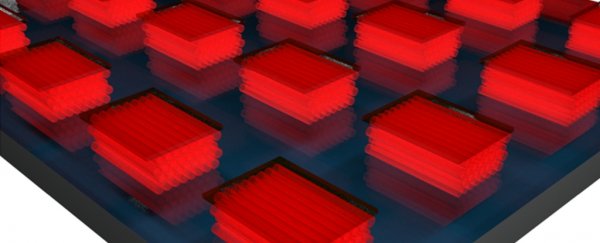Solar cells that transfer sunlight into electricity are a brilliant part of modern technology, but one particular aspect has proven to be a huge headache. They're not super efficient - most of the sunlight they absorb is lost in the form of heat.
As a result, the average efficiency of a commercial solar panel is between 11 and 22 percent. Now, a new device could boost that to a whopping 80 percent.
The design is based on an array of single-wall carbon nanotubes, which recapture the thermal photons of infrared radiation - that's the heat - lost by solar cells. Then, the device emits that energy as light in a different wavelength, which in turn can be recycled into electricity.
"Thermal photons are just photons emitted from a hot body," explained engineer Junichiro Kono of Rice University. "If you look at something hot with an infrared camera, you see it glow. The camera is capturing these thermally excited photons."
Infrared radiation is the part of sunlight that carries warmth. It's invisible to the naked human eye, but is on the same electromagnetic spectrum as light and radio waves, and X-rays. It's emitted by your stove, or a campfire, or even by your warm cat, purring on your lap. Basically, anything that emits heat is emitting infrared radiation.
"The problem," said engineer Gururaj Naik, "is that thermal radiation is broadband, while the conversion of light to electricity is efficient only if the emission is in a narrow band. The challenge was to squeeze broadband photons into a narrow band."
Their system involved fine films of densely packed carbon nanotubes, already developed by Kono and colleagues in 2016.
One of the properties of these nanotubes is that electrons in them can only travel in one direction. This produces an effect called hyperbolic dispersion, whereby the films are metallic conductors in one direction, but insulators perpendicular to that direction.
That means that the thermal photons can enter from pretty much anywhere… but they can only exit one way. This squeezing process converts the heat to light; from there, it can be converted into electricity.
In the proof-of-concept device the team developed, the carbon nanotube film can withstand temperatures up to 700 degrees Celsius (1,292 Fahrenheit), although the material is capable of withstanding a much higher heat, up to 1,600 degrees Celsius (1,292 Fahrenheit).
The engineering team then subjected their device to a heat source to confirm the narrow-band output. Each one of the resonator cavities in the film reduced the band of the thermal photons, producing light.
The next step in the research will be to collect this light using photovoltaic solar cells and converting it to electricity to confirm efficiency predictions.
"By squeezing all the wasted thermal energy into a small spectral region, we can turn it into electricity very efficiently," Naik said.
"The theoretical prediction is that we can get 80 percent efficiency."
The research has been published in ACS Photonics.
